
Alectryon is a genus of about 30 species of trees and shrubs from the family Sapindaceae. They grow naturally across Australasia, Papuasia, Melanesia, western Polynesia, east Malesia and Southeast Asia, including across mainland Australia, especially diverse in eastern Queensland and New South Wales, the Torres Strait Islands, New Guinea, the Solomon Islands, New Caledonia, New Zealand, Vanuatu, Fiji, Samoa, Hawaii, Indonesia and the Philippines. They grow in a wide variety of natural habitats, from rainforests, gallery forests and coastal forests to arid savannas and heaths.
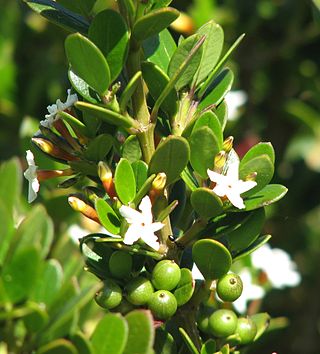
Alyxia is an Australasian genus of flowering plant in the dogbane family, Apocynaceae. It contains at present 106 species, but Alyxia stellata and A. tisserantii are very variable, might be cryptic species complexes, and are need of further study. It consists of shrubby, climbing or scrambling plants. This genus occurs in China, the Himalayas, Southeast Asia, Australia, New Caledonia and the Pacific Islands. There are 14 species in Australia, 21 in New Caledonia and 7 in the other Pacific Islands, including Hawaiʻi.
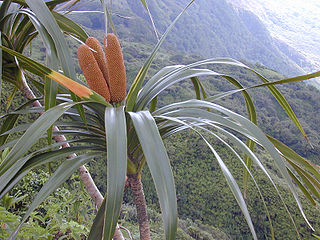
Freycinetia is one of the five extant genera in the flowering plant family Pandanaceae. The genus comprises approximately 180–200 species, most of them climbers.
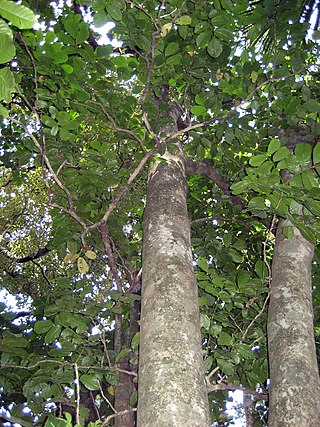
Dysoxylum is a flowering plant genus of trees and shrubs from the mahogany family, Meliaceae.

Chionanthus, common name: fringetrees, is a genus of about 150 species of flowering plants in the family Oleaceae.

Elattostachys is a genus of about 21 species of trees known to science, constituting part of the plant family Sapindaceae.
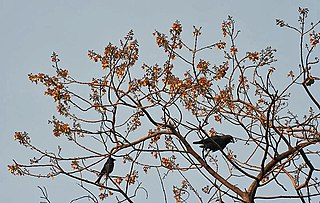
Gmelina is a genus of plants in the family Lamiaceae. It consists of about 35 species in Australia, New Guinea, New Caledonia, Southeast Asia, India and a few in Africa. Some species such as G. arborea have been planted and/or become naturalised in India, Africa and Australia. It was named by Carl Linnaeus in honour of botanist Johann Georg Gmelin.

Gomphandra is a genus of plant in family Stemonuraceae. They are dioecious trees or shrubs. The genus includes 44 accepted species, which range from India through Indochina to southern China and Taiwan, and through Malaysia, Indonesia, and the Philippines to New Guinea, Queensland, and the Solomon Islands.

Melodinus is a genus of plant in the family Apocynaceae, first described as a genus in 1776. It is native to Indomalaya, Meganesia and various islands in the western Pacific. A type of monoterpenoid indole alkaloids called melodinines can be isolated from Melodinus plants.
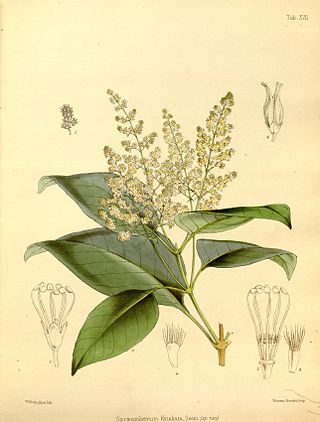
Spiraeanthemum is a genus of trees and shrubs in the family Cunoniaceae. it includes about 19 species from Australia, New Guinea, Solomon Islands, New Caledonia, Vanuatu, Fiji and Samoa. Leaves are simple, opposite or whorled, with toothed or entire margins. Inflorescences are paniculate, flowers unisexual or hermaphrodite, and the fruits are follicular with free carpels. It belongs to the tribe Spiraeanthemeae, and now includes the species formerly placed in Acsmithia.

Zygogynum is a genus of plant in the winter's bark family Winteraceae. 19 species are native to New Caledonia, and are pollinated primarily by beetles and moths. Other species are native to New Guinea, the Bismarck Archipelago, the Solomon Islands, Lord Howe Island, and Queensland.

Gahnia is a genus of sedges native to China, Southeast Asia, New Guinea, Australia, New Zealand and a number of Pacific Islands. The common name is due to the toothed margins. It often forms tussocks.

Styphelia is a genus of shrubs in the family Ericaceae, native from Indo-China through the Pacific to Australia. Most have minute or small leaves with a sharp tip, single, tube-shaped flowers arranged in leaf axils and with the ends of the petals rolled back with hairs in the inside of the tube.

Atractocarpus is a genus of flowering plants in the family Rubiaceae. Its members are commonly known as native gardenias in Australia. The genus name is derived from the Ancient Greek terms atractos "spindle", and karpos "fruit", from the spindle-shaped fruit of the type species.

Octarrhena, commonly known as grub orchids, is a genus of flowering plants from the orchid family, Orchidaceae. Plants in this genus are small, orchids with short stems, thin roots, short, thick, fleshy leaves arranged in two ranks and tiny flowers. The labellum is rigidly attached to the base of the column. There are about fifty species native to areas from Sri Lanka and Malesia to the Western Pacific.

Peristylus, sometimes commonly known as ogre orchids or bog orchids is a genus of flowering plants from the orchid family, Orchidaceae. It consists of over 100 known species found across much of eastern and southern Asia as well as in Australia and on many islands of the Indian and Pacific Oceans.
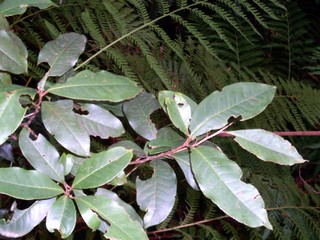
Quintinia is a genus of about 25 evergreen trees and shrubs native to the Philippines, New Guinea, New Zealand, New Caledonia, Vanuatu and Australia. Plants have alternate leaves. White or lilac flowers form at the end of stalks or on leaf axils. The fruiting body is a capsule, usually containing a large number of tiny seeds. The genus is named after the gardener Jean-Baptiste de la Quintinie.
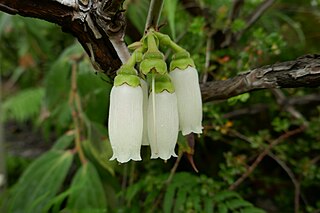
Dimorphanthera is a genus of flowering plants belonging to the family Ericaceae.

Leichhardtia is a genus of flowering plants in the dogbane family (Apocynaceae). It includes 85 species native to mainland Australia, Papuasia, New Caledonia, and Lord Howe Island.
















